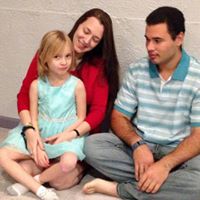Nicholas L Kramer
age ~31
from Fort Lauderdale, FL
- Also known as:
-
- Nicholas Lehmann Kramer
Nicholas Kramer Phones & Addresses
- Fort Lauderdale, FL
- Hoffman Estates, IL
- Fort Worth, TX
- El Dorado Hills, CA
- El Dorado Hls, CA
Specialities
Trusts & Estates • Estate Planning
Resumes

Senior Systems Engineer
view sourceLocation:
San Francisco, CA
Work:
Magic Leap
Senior Systems Engineer
Senior Systems Engineer
Education:
Cornell University

Sales Inspector At Orkin Pest Control
view sourceLocation:
United States
Industry:
Consumer Services
Lawyers & Attorneys

Nicholas Kramer - Lawyer
view sourceSpecialties:
Trusts & Estates
Estate Planning
Estate Planning
ISLN:
924179708
Admitted:
2015
University:
Pepperdine Univ SOL; Malibu CA; Univ of Washington; Seattle WA
Medicine Doctors

Nicholas F Kramer
view sourceUs Patents
-
Systems, Methods, And Devices For Non-Human Readable Diagnostic Tests
view source -
US Patent:20220406458, Dec 22, 2022
-
Filed:Jun 21, 2022
-
Appl. No.:17/807934
-
Inventors:- Miami FL, US
Zachary Carl Nienstedt - Wilton Manors FL, US
Sam Miller - Hollywood FL, US
Marco Magistri - Miami FL, US
Nicholas Atkinson Kramer - Wilton Manors FL, US
James Thomas Heising - Richard WA, US -
International Classification:G16H 50/20
G16H 50/30
G16H 40/67 -
Abstract:Systems and methods for ensuring medical diagnostic test integrity are disclosed. In particular, systems and methods herein can be used to ensure compliance with testing procedures. Some embodiments provide systems and methods for verifying test results. According to some embodiments, test results can be non-human-readable results that can be interpreted by a computing system.
-
Transmodal Input Fusion For A Wearable System
view source -
US Patent:20210056764, Feb 25, 2021
-
Filed:Nov 5, 2020
-
Appl. No.:17/090115
-
Inventors:- Plantation FL, US
Samuel A. Miller - Hollywood FL, US
Nicholas Atkinson Kramer - Ft. Lauderdale FL, US
David Charles Lundmark - Los Altos CA, US -
International Classification:G06T 19/00
G06F 3/16
G06F 3/01
G06T 7/70
G06T 5/20 -
Abstract:Examples of wearable systems and methods can use multiple inputs (e.g., gesture, head pose, eye gaze, voice, totem, and/or environmental factors (e.g., location)) to determine a command that should be executed and objects in the three-dimensional (3D) environment that should be operated on. The wearable system can detect when different inputs converge together, such as when a user seeks to select a virtual object using multiple inputs such as eye gaze, head pose, hand gesture, and totem input. Upon detecting an input convergence, the wearable system can perform a transmodal filtering scheme that leverages the converged inputs to assist in properly interpreting what command the user is providing or what object the user is targeting.
-
Augmented Reality Systems And Methods For User Health Analysis
view source -
US Patent:20200405257, Dec 31, 2020
-
Filed:Sep 15, 2020
-
Appl. No.:17/021922
-
Inventors:- Plantation FL, US
Mark Baerenrodt - Millbrae CA, US
Nastasja U. Robaina - Coconut Grove FL, US
Charlotte Dorothea Wilhelmina Vinkers - Fort Lauderdale FL, US
Christopher M. Harrises - Nashua NH, US
Nicholas Atkinson Kramer - Fort Lauderdale FL, US -
International Classification:A61B 7/04
G06F 3/01
G02B 27/01
A61B 3/113
A61B 5/01
A61B 5/021
A61B 5/145
A61B 5/024
A61B 5/00 -
Abstract:Augmented reality systems and methods for user health analysis. Methods for user health analysis may include collecting data for an initial prediction model and continuing to collect additional data based on one or more data criteria. The methods may further include updating the initial prediction model based on the additional data to produce a revised prediction model or causing an intervention to occur based on the additional data. The data may be collected by a display system including one or more sensors configured to collect user-specific data and a display device configured to present virtual content to a user. The display device may be configured to output light with variable wavefront divergence.
-
Transmodal Input Fusion For A Wearable System
view source -
US Patent:20190362557, Nov 28, 2019
-
Filed:May 21, 2019
-
Appl. No.:16/418820
-
Inventors:- Plantation FL, US
Samuel A. Miller - Hollywood FL, US
Nicholas Atkinson Kramer - Ft. Lauderdale FL, US
David Charles Lundmark - Los Altos CA, US -
International Classification:G06T 19/00
G06F 3/16
G06F 3/01
G06T 7/70
G06T 5/20 -
Abstract:Examples of wearable systems and methods can use multiple inputs (e.g., gesture, head pose, eye gaze, voice, totem, and/or environmental factors (e.g., location)) to determine a command that should be executed and objects in the three-dimensional (3D) environment that should be operated on. The wearable system can detect when different inputs converge together, such as when a user seeks to select a virtual object using multiple inputs such as eye gaze, head pose, hand gesture, and totem input. Upon detecting an input convergence, the wearable system can perform a transmodal filtering scheme that leverages the converged inputs to assist in properly interpreting what command the user is providing or what object the user is targeting.
-
Augmented Reality Systems And Methods For User Health Analysis
view source -
US Patent:20170323485, Nov 9, 2017
-
Filed:May 9, 2017
-
Appl. No.:15/590922
-
Inventors:- Plantation FL, US
Mark Baerenrodt - Delray Beach FL, US
Nastasja U. Robaina - Coconut Grove FL, US
Charlotte Dorothea Wilhelmina Vinkers - Fort Lauderdale FL, US
Christopher M. Harrises - Nashua NH, US
Nicholas Kramer - Fort Lauderdale FL, US -
International Classification:G06T 19/00
A61B 5/01
A61B 5/021
G06F 3/01
A61B 5/024
A61B 3/113
A61B 7/04
A61B 5/145
G02B 27/01
A61B 5/00
F21V 8/00
G02B 27/01
G02B 27/01
G02B 27/01 -
Abstract:Augmented reality systems and methods for user health analysis. Methods for user health analysis may include collecting data for an initial prediction model and continuing to collect additional data based on one or more data criteria. The methods may further include updating the initial prediction model based on the additional data to produce a revised prediction model or causing an intervention to occur based on the additional data. The data may be collected by a display system including one or more sensors configured to collect user-specific data and a display device configured to present virtual content to a user. The display device may be configured to output light with variable wavefront divergence.
Name / Title
Company / Classification
Phones & Addresses
PRO STAR FACILITY SERVICES INC
Classmates

Nicholas Kramer
view sourceSchools:
Lanoka Harbor Elementary School Lanoka Harbor NJ 1974-1974, Clara B. Worth Elementary School Bayville NJ 1993-2000
Community:
Heather Boarman, William Mortimer, Sue Korkusuz, Kelly Louis, Joshua Praznic, Robert Muller, Paul Melicia, Melissa Jensen

Bell Middle School, Milwa...
view sourceGraduates:
Nicolas Radovancevic (1982-1984),
Nick Radovancevic (1979-1983),
Nick Kramer (1990-1992)
Nick Radovancevic (1979-1983),
Nick Kramer (1990-1992)

Riverdale High School, Mu...
view sourceGraduates:
Nicholas Adam Kramer (1990-1994),
Kim Phetteplace (1983-1987),
Robert Hillberry (1976-1980),
Carol Peer (1966-1970)
Kim Phetteplace (1983-1987),
Robert Hillberry (1976-1980),
Carol Peer (1966-1970)
Youtube
Myspace
Googleplus

Nicholas Kramer
Education:
Cornell - ECE, York College of Pennsylvania - ECE
Tagline:
*witty one-liner placeholder until I actually use Google+*

Nicholas Kramer
Education:
Green River Community College

Nicholas Kramer

Nicholas Kramer

Nicholas Kramer

Nicholas Kramer

Nicholas Kramer

Nicholas Kramer

Nicholas Kramer
view source
Nicholas Kramer
view source
Nicholas Kramer
view source
Nicholas B Kramer
view source
Ryan Nicholas Kramer
view source
Nicholas Kramer
view source
Nicholas Kramer
view source
Nicholas Cash Kramer
view sourceFlickr
News

Eastern Iowa authorities say 4 killed in collision were 14-year-old boys from ...
view source- Sean Kenneally, Mitchell Kluesner, Nicholas Kramer and Bryce Wilwert, all 14, were friends from the Epworth area and planned to begin their freshman year at Western Dubuque High School in the fall, The Dubuque Telegraph Herald (http://bit.ly/1sk9tka ) reported. Before the accident, they participated
- Date: Aug 04, 2014
- Category: U.S.
- Source: Google

Questions Remain In Epworth Fatalities
view source- Epworth. Four 14-year-old boys Bryce Wilbert of Epworth, Sean Kenneally of Peosta, Mitchell Kluesner of Epworth and Nicholas Kramer of Dyersville were operating a John Deere Gator a small, utility vehicle when they were hit by a truck driven by 24-year-old Joseph Connolly, of Holy Cross. Con
- Date: Aug 04, 2014
- Category: U.S.
- Source: Google
Get Report for Nicholas L Kramer from Fort Lauderdale, FL, age ~31

















